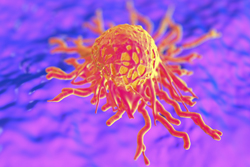Fighting cancer metastasis
The process of metastasis involves the detachment of cells from the primary tumour into blood to circulate and infiltrate new organs, and initiate new tumour formation. For tumour cells to mobilise cell adhesion mechanisms have to be disrupted and cellular adhesive capacity needs to increase for reattachment to metastatic sites. Integrins control cell migration, cell–cell interaction and differentiation and play an instrumental role in tumour developmental processes. Based on this, leading research groups in the field teamed up under the EU-funded 'Understanding and fighting metastasis via dissection of the core invasive machinery' (METAFIGHT) project. They aimed to dissect the molecular pathways responsible for metastasis and find new candidate targets for blocking it. Partners were particularly interested in studying the role of integrin adhesion molecules, as metastasis induces changes when cancer cells interact with their microenvironment. The interaction networks responsible for integrin-mediated attachment to the extracellular matrix consist of the focal adhesion kinase (FAK), various effector molecules such as small GTPases and adaptor proteins. This is depicted on the project’s website, available at http://www.metafight.eu/core_invasive_machinery.php(opens in new window) online. METAFIGHT scientists investigated how metastatic cells change their molecular architecture and the signals that determine their invasive and migratory cell phenotype. The core invasive machinery was dissected and the impact of individual proteins in cancer growth and metastasis was studied in specific animal models. This line of work identified both positive (AnxA1, Anx2, Vav2, Vav3, FAK, Pak4, Paxillin) and negative regulators (constitutively active G13 mutant proteins, p140Cap) of metastasis. In addition, protein modifications and signalling elements pivotal for cancer cell dissemination were also identified. Particular emphasis was placed on the development of a breast cancer animal model. Researchers used this model to interfere with various genes in breast cancer cells prior to transplanting them in mice. This enabled them to evaluate the role of candidate metastasis genes in mammary gland tumour formation, and unveil the role of p130Cas and p140Cap as an oncogene and tumour suppressor, respectively. Additionally, through innovative non-invasive imaging techniques, partners followed the fate of single metastatic cells. Specialised software was developed for analysing integrin clustering and obtaining three-dimensional (3D) images of live cells. METAFIGHT also included a translational dimension with tissue microarray analysis of over 150 breast cancer samples, which led to the correlation of candidate genes with clinical parameters. Combined with the discovery of inhibitory compounds, partners wished to provide novel pharmaceutical targets and avenues for inhibiting cancer metastasis.







